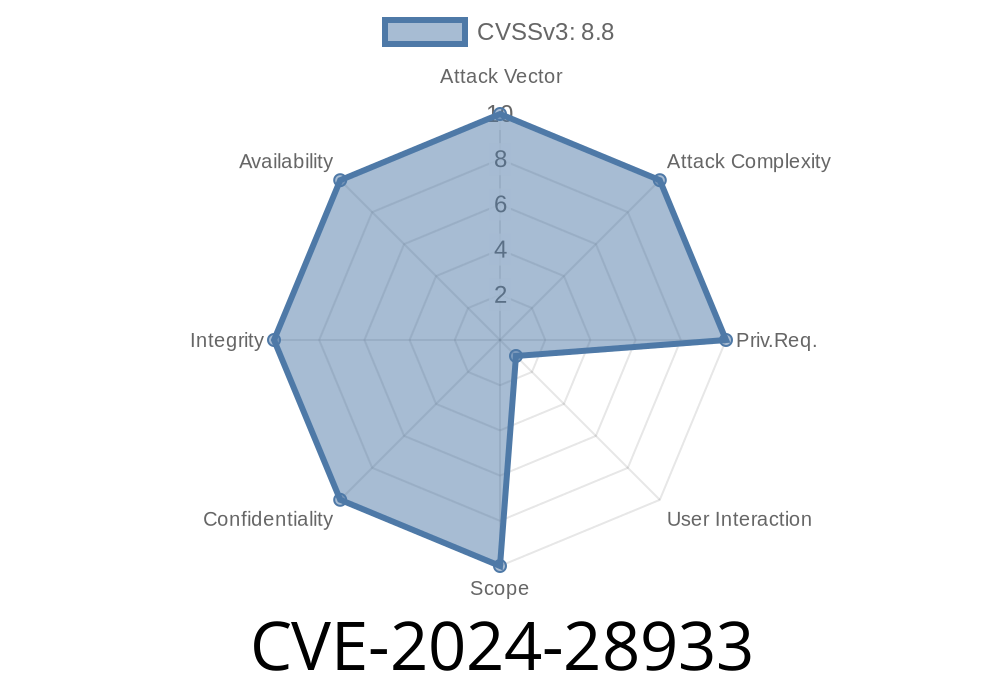A new vulnerability, CVE-2024-28933, has been identified in the Microsoft ODBC Driver for SQL Server that allows attackers to execute malicious code remotely. This vulnerability poses a significant risk to businesses and organizations using this software, as cybercriminals can gain unauthorized access, exfiltrate sensitive data, or launch targeted attacks. In this blog post, we will discuss the exploit's details, provide code snippets, and outline various mitigation techniques.
Background
The Microsoft ODBC (Open Database Connectivity) driver for SQL Server allows applications to interact with SQL Server databases. It enables a standard set of APIs to access data stored in databases, regardless of its structure and format, easing data management and increasing application efficiency.
Code Snippet Example
The following code snippet provides an example of how the ODBC driver is used to connect to SQL Server:
#include <iostream>
#include <sql.h>
#include <sqlext.h>
int main()
{
SQLHENV hEnv;
SQLHDBC hDbc;
SQLRETURN retcode;
// Allocate the environment handle
retcode = SQLAllocHandle(SQL_HANDLE_ENV, SQL_NULL_HANDLE, &hEnv);
// Set environment attributes
if (retcode == SQL_SUCCESS || retcode == SQL_SUCCESS_WITH_INFO) {
retcode = SQLSetEnvAttr(hEnv, SQL_ATTR_ODBC_VERSION, (SQLPOINTER)SQL_OV_ODBC3, );
// Allocate a connection handle
retcode = SQLAllocHandle(SQL_HANDLE_DBC, hEnv, &hDbc);
// Connect to SQL Server
if (retcode == SQL_SUCCESS || retcode == SQL_SUCCESS_WITH_INFO) {
retcode = SQLConnect(hDbc, (SQLCHAR *)"YOUR_DSN_NAME", SQL_NTS, (SQLCHAR *)"YOUR_USERNAME", SQL_NTS, (SQLCHAR *)"YOUR_PASSWORD", SQL_NTS);
if (retcode == SQL_ERROR) {
std::cout << "Connection error!" << std::endl;
} else {
std::cout << "Connected to SQL Server." << std::endl;
}
}
}
// Cleanup
SQLDisconnect(hDbc);
SQLFreeHandle(SQL_HANDLE_DBC, hDbc);
SQLFreeHandle(SQL_HANDLE_ENV, hEnv);
return ;
}
This code creates a basic connection to an SQL Server using ODBC driver. However, due to the presence of CVE-2024-28933, this code is vulnerable to attacks that can lead to remote code execution.
Vulnerability Details
The CVE-2024-28933 vulnerability lies in the handling of memory allocation by the ODBC driver. Attackers can exploit this vulnerability by sending a specially crafted SQL query to trigger a heap-based buffer overflow. This overflow allows them to overwrite adjacent memory space and execute code remotely on the targeted system, causing potential data breaches and system havoc.
Exploit Reference
A detailed analysis of the exploit, including technical specifications and proofs of concept, can be found at the following link:
Mitigation Techniques
We strongly recommend the following mitigation strategies to protect your systems from the CVE-2024-28933 vulnerability:
1. Patch your systems: Ensure that all your SQL Server instances and ODBC drivers are updated with the latest security updates provided by Microsoft. Regular patching is essential to maintain a secure environment.
2. Restrict access: Implement strict access controls and limit the number of users who can interact with SQL databases, especially those with elevated privileges. Use firewalls to block any remote access to SQL servers unless absolutely necessary.
3. Input validation: Enforce strict input validation and sanitization to prevent the execution of malicious SQL queries.
4. Monitor and detect: Implement a security monitoring solution that can detect suspicious activities, such as unusual database queries or unauthorized access attempts. Regularly audit your logs to stay on top of any potential security threats.
Conclusion
The CVE-2024-28933 vulnerability in the Microsoft ODBC Driver for SQL Server is a serious issue that demands urgent attention. By understanding how it works, applying the recommended mitigation techniques, and staying informed about updates from software providers, businesses and organizations can minimize their exposure to this dangerous remote code execution threat.
Timeline
Published on: 04/09/2024 17:15:54 UTC
Last modified on: 04/10/2024 13:24:00 UTC
